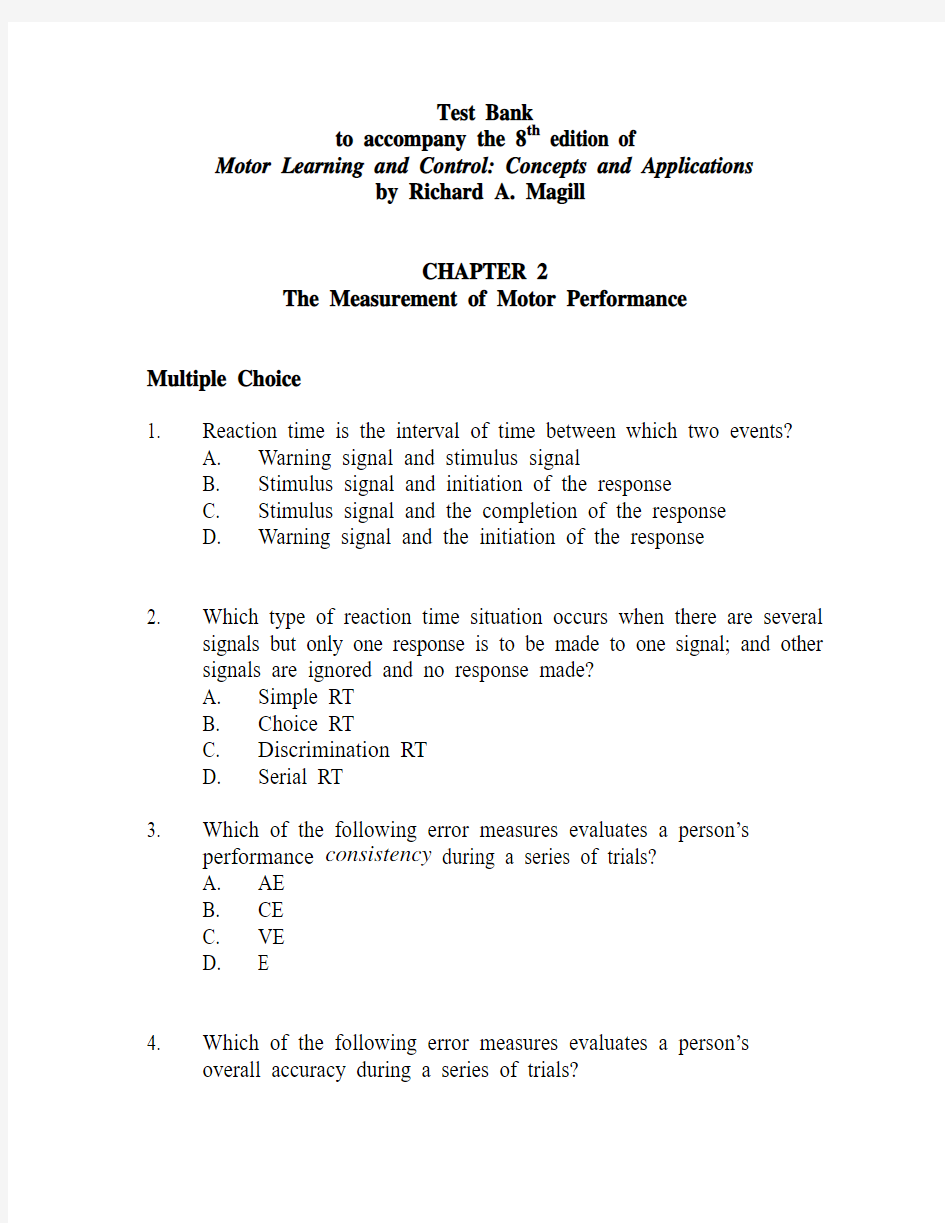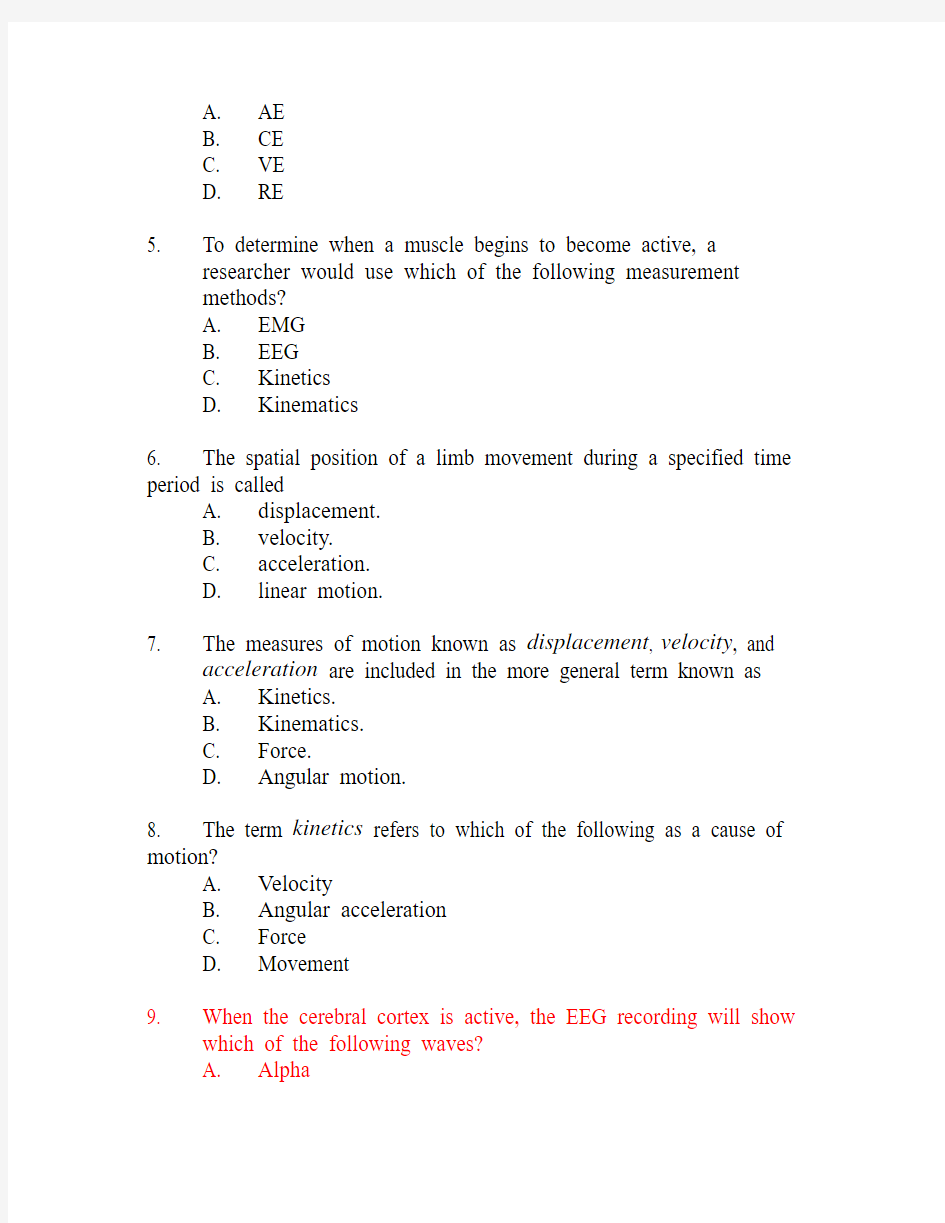magill8e_testbank_ch02


Test Bank
to accompany the 8th edition of
Motor Learning and Control: Concepts and Applications
by Richard A. Magill
CHAPTER 2
The Measurement of Motor Performance
Multiple Choice
1. Reaction time is the interval of time between which two events?
A. Warning signal and stimulus signal
B. Stimulus signal and initiation of the response
C. Stimulus signal and the completion of the response
D. Warning signal and the initiation of the response
2. Which type of reaction time situation occurs when there are several
signals but only one response is to be made to one signal; and other signals are ignored and no response made?
A. Simple RT
B. Choice RT
C. Discrimination RT
D. Serial RT
3. Which of the following error measures evaluates a person’s
performance consistency during a series of trials?
A. AE
B. CE
C. VE
D. E
4. Which of the following error measures evaluates a person’s
overall accuracy during a series of trials?
A. AE
B. CE
C. VE
D. RE
5. To determine when a muscle begins to become active, a
researcher would use which of the following measurement
methods?
A. EMG
B. EEG
C. Kinetics
D. Kinematics
6. The spatial position of a limb movement during a specified time period is called
A. displacement.
B. velocity.
C. acceleration.
D. linear motion.
7. The measures of motion known as displacement, velocity, and
acceleration are included in the more general term known as
A. Kinetics.
B. Kinematics.
C. Force.
D. Angular motion.
8. The term kinetics refers to which of the following as a cause of motion?
A. Velocity
B. Angular acceleration
C. Force
D. Movement
9. When the cerebral cortex is active, the EEG recording will show
which of the following waves?
A. Alpha
B. Beta
C. Theta
D. Delta
10. Which of the following brain activity measurement techniques
realigns the body’s hydrogen atoms and can provide
extraordinarily clear 2D and 3D images of the brain?
A. EEG
B. PET
C. EMG
D. fMRI
Short Answer
11. The interval of time between the initiation and completion of a
movement is called ______.
12. A person had the following error scores for a series of 5 trials: +5,
-3, +8, +18, -6. The average AE score is ________.
13. Variable error is an indicator of a person’s performance
________ when performing a skill that requires hitting a target.
14. The kinematics measure of motor performance that describes the
speeding up and slowing down of a movement is called
________.
15. The method of recording electrical activity in the muscles during
movement is called ________.
16. If you want to describe the movement of an object in a straight
line, the type of motion you would describe is referred to as
________.
17. Force can be calculated from the kinematics of a movement if
you know the mass of the moving object and the ________ of the movement.
18. The rotary force of body segments around their joints axes is
known as joint ________.
19. The brain activity measurement technique that shows blood flow
in the brain is known as ________.
20. The calculation of ______________ provides an objective
measure of the coordination between two limbs or limb segments by comparing the specific location of each limb or limb segment in one cycle of a cyclic movement.
True-False
21. Simple RT involves one signal and more than one possible responses.
22. Constant error (CE) refers to a person’s performance bias during
a series of trials.
23. Radial error (RE) would be the appropriate general accuracy
measure to assess the accuracy of a golf putt.
24. When a performance score is recorded as m/sec, the performance
measure is velocity.
25. If you move your two arms forward and backward several times
at the same time, the phase relationship between them is 0
degrees.
